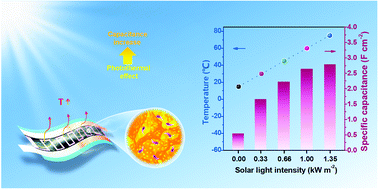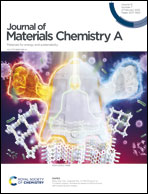Enhancing the energy storage capacity of graphene supercapacitors via solar heating†
Abstract
Enhancing the energy storage capacity of supercapacitors is facing great challenges. Converting solar energy into heat energy has emerged as a promising strategy to enhance the capacity of energy storage devices by elevating their working temperature, especially under low-temperature conditions. Unlike traditional energy storage devices, higher requirements are put forward for the cycle stability of solar thermal device electrodes. Herein, a novel light-absorbing structure of supercapacitor electrodes composed of 3D porous graphene and polypyrrole is established. The uniform composite structure and matching thermal expansion properties of the composite electrode endows the fabricated solar-thermal micro-supercapacitor (ST-MSC) with superior capacitance and cycling stability. Under one solar irradiation, the temperature of the ST-MSC increases to 60 °C, leading to a 4.8-fold increase in the specific capacitance and energy density (up to 2754 mF cm−2 and 646.6 µW h cm−2, respectively); the ST-MSC exhibits excellent cycle stability with 85.8% capacitance retention after 10 000 cycles, which is much better than most of the reported ST-MSCs. Moreover, at a low temperature of −30 °C, the severely attenuated capacitance performance of the ST-MSC is greatly improved under one solar irradiation to a level close to that at room temperature. This work provides a new strategy for designing solar thermal electrodes and their derived high-performance energy storage devices.



 Please wait while we load your content...
Please wait while we load your content...